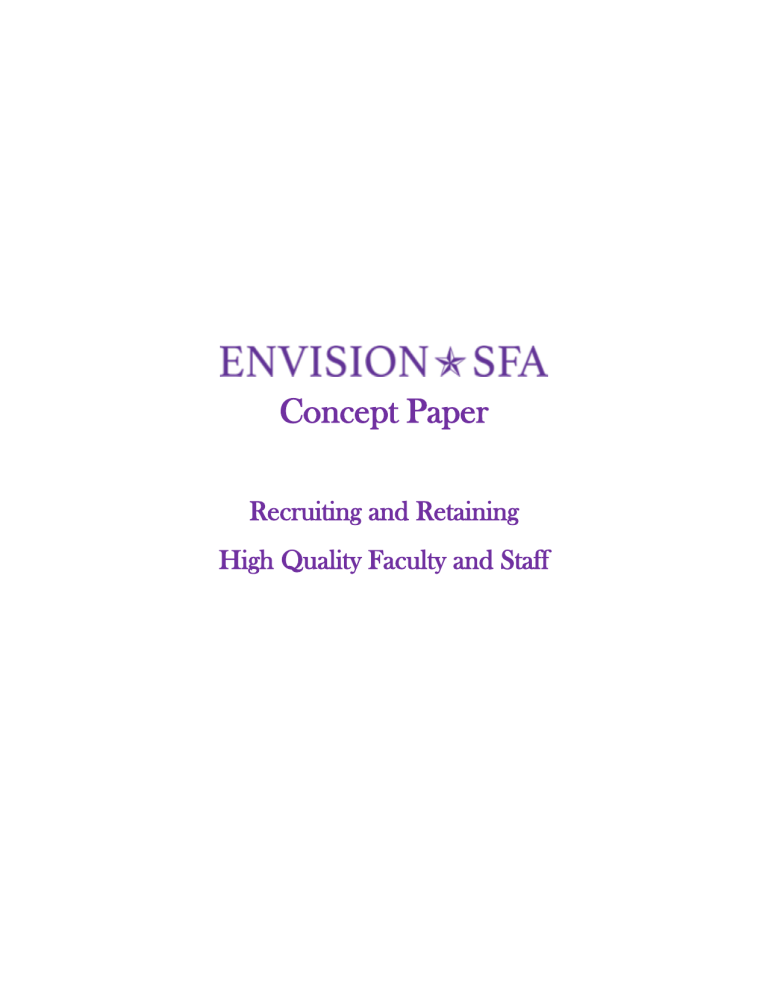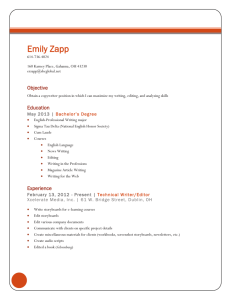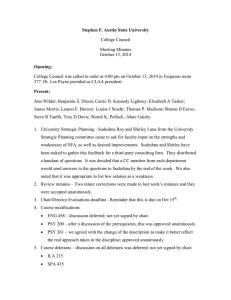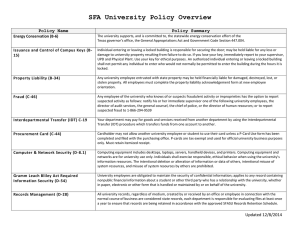Concept Paper Recruiting and Retaining High Quality Faculty and Staff

Concept Paper
Recruiting and Retaining
High Quality Faculty and Staff
SFA Strategic Plan Concept Paper Spring 2015
Recruiting and Retaining High Quality Faculty and Staff
Background
Recruitment and retention of high quality faculty and staff has historically been at the forefront of SFA strategic planning. Recognizing that faculty and staff compensation lies at the root of this issue, other factors have likely influenced the overall effectiveness of recruitment and retention efforts. These factors include the need for effective orientation of faculty and staff, transparency of budget matters that impact salaries, and targeted effective professional development for faculty and staff.
Faculty compensation
The issue of low faculty salaries has appeared as a primary objective in all recent strategic plans; however, little progress has been made in improving the ranking of SFA faculty salaries relative to other universities in
Texas. Consequently, in 2014 two distinct studies of SFA faculty salaries were completed, both of which used data from the Texas Higher Education Coordinating Board (THECB) as the primary source.
One study, initiated by the SFA Faculty Senate, was an analysis of SFA faculty salaries over FY12 relative to
18 peer institutions in Texas. This study was completed by SFA statistician, Dr. Robert Henderson, and considered several factors assumed to be related to the salary comparison, including enrollment, class size, percent graduate enrollment, tuition and fees, endowment, general revenue, gender and rank. To strengthen the validity of results at the institutional level in this peer institution (PI) study, Dr. Henderson adjusted the data for gender, rank, institutional revenue and local cost of living. Results revealed a number of significant differences in median pay levels between SFA and peer institutions and suggested specific improvement strategies.
A second study, commissioned by the SFA Board of Regents, was an analysis by the SFA Academic Research
Committee (ARC) comparing FY13 SFA faculty salary rankings by quarters to salaries at 37 other Texas colleges and universities. This ARC study also considered other specific factors assumed to have significant relationship to salaries, including faculty rank, semester credit hours, faculty headcount/full-time faculty equivalent, class efficiency (size/utilization), and financial information (revenue/expenses). Results from this study also revealed significant differences in pay levels. Since the ARC study involved many large institutions that included research-level universities, the comparative results cannot necessarily be used to support specific strategies. However, the key observations were complementary to the PI study and may suggest areas for additional analysis.
Summary observations from the Peer Institution study
1.
SFA faculty salaries compared to those at peer institutions differ significantly by rank and discipline.
2.
At all tenure/tenure-track ranks a relatively large number of departments at SFA have adjusted average salaries that are significantly below the peer institution median salaries. However, at both the assistant and associate professor levels, there are also several departments with average adjusted salaries significantly above median salaries at peer institutions.
3.
Data suggest that across the board salary increases may still leave many department/rank combinations paid at levels below their peer group medians. Targeted increases may be a more appropriate strategy.
1
SFA Strategic Plan Concept Paper Spring 2015
Summary observations from the Academic Research Committee study
4.
SFA fell approximately in the middle of the four groupings (quarters) of institutions when comparing full-time faculty equivalent (headcount), but it fell below all four group averages in percentage production of high-funded undergraduate level semester credit hours. Furthermore, SFA generates no higher-funded special/professional semester credit hours.
5.
Institutions with higher expenses and administrative costs typically report lower salary averages; however, SFA operating expenses and administrative costs are lower than all quarter group averages.
6.
Though average faculty salaries rank 34 of 38, SFA average tuition and fees rank between the first and second quarter group averages and overall revenue is between the second and third, suggesting that support for salary increases must come from initiatives other than increased tuition and fees.
7.
As a current strategy to increase enrollment, SFA reports the enhancement/development of marketing efforts. These efforts add significant expense with as yet unproven and under-evaluated results.
Staff compensation
Data collected from the College and University Professional Association (CUPA) for Human Resources through the SFA Office of Human Resources considered salaries across administrative, professional, and nonexempt categories. Using national surveys unique to higher education institutions and the state of Texas
Compensation/Classification System, each SFA job group was examined/measured for external equity.
Summative findings indicate that from 2009 to 2014, the SFA percent of the national and state equity average for staff increased by 5%. However, since these percentages are based on national and state equity averages, interpretation of the results remains inconclusive. More detailed and statistically valid analysis of these results is necessary to develop a strategic response.
No study was available comparable to the faculty salaries study initiated by Faculty Senate that utilized the intervention of a statistician for data collection and interpretation. Implementation of this type of study would provide significant and complementary findings.
Executive Summary: Faculty Salaries
Although a number of institutional level variables were considered in the PI study, it was discovered that institutional revenue was highly correlated with many of these covariates, most notably enrollment, class size, tuition and fees, and endowment. Thus, adjusting for institutional revenue captured the impact of these other factors as well. In addition, the data were adjusted for gender, rank, and local cost of living to strengthen the validity of results. These adjusted results were then evaluated by SFA department and rank, with some results from similar departments at the peer institutions being combined in order to establish respective peer groups for the SFA departments.
Analysis of results for 2012 SFA and peer institution salaries suggest that there are a number of significant differences in median pay levels between SFA and the peer institutions . For assistant professors, the median
SFA salary is lower than the median peer group salary for 19 of the 31 departments considered, with 8 of these
19 being significantly lower. For associate professors, the median SFA salary is lower than the median peer group salary for 18 of the 28 departments considered, with 12 of these 18 being significantly lower. At the professor level, 20 of the 28 SFA departments have median salaries less than the median salaries of the peer group and 5 of these 20 are significantly lower. Also of note is that SFA median salaries are significantly greater than those of the peer group for 5 departments at
both the assistant and associate professor levels, but
2
SFA Strategic Plan Concept Paper Spring 2015 no SFA department reports median salaries at the professor level significantly larger than their corresponding peer group.
From a pure frequency approach, if SFA was paying faculty at the same median level as the peer group institutions, it would be expected that approximately half of the 87 SFA department/rank combinations would be lower and half higher than the peer group result. The data instead shows that 57 of 87 median SFA salaries are lower than their respective peer group medians, clearly indicating that many SFA department/rank combinations are underpaid relative to their respective peer groups.
The important point is that these data suggest that any across the board salary increase could still leave many department/rank combinations being paid at levels below their peer group medians and that targeted increases would likely be more appropriate . The political issue with such an approach is obviously that some faculty members would receive peer group related raises and some would not. In addition, the magnitudes of any raises would be expected to be different in real dollars (as well as percentages) across department and rank combinations. The available data suggests that in order to raise the median adjusted salaries for department and rank combinations currently paid below their corresponding peer group median salaries up to 100% of the peer group median, targeted increases likely would
be in the neighborhood of $3M annually.
Lessons Learned
Findings and recommendations from previous SFA strategic planning processes have highlighted concerns regarding the recruitment and retention of high quality faculty and staff. However, findings that are noted but not followed by definitive action often fade into the backdrop of the higher education landscape as daily demands of regular responsibilities across campus receive priority attention. Without a detailed action plan and accountability system, those findings go unattended and unchanged. Broad targets set with no strategic implementation plan often prove to be ineffective.
National Trends in Higher Education
Given the costs and value of higher education, as state budgets have become tighter and student fees have risen, governors/legislators have sought to ensure attention to state priorities, to control institutional costs by regulating academic matters, and to demand evidence of accountability regarding student outcomes.
Lawmakers are increasingly focused on outcomes-based funding that shifts financial support criteria from headcount to completion rates.
Through a Chronicle of Higher Education survey, four-year college presidents ranked inadequate faculty salaries highest on their list of faculty concerns. Because of the unique characteristics of the academy, faculty issues are always a matter of great interest and high emotion.
Historical observations are as follows:
1.
Compensation programs in institutions of higher education are generally designed around the major categories of workers: faculty, student workers, graduate assistants, administrators and professionals, executives, and a large group of staff. Increasingly, institutions are migrating to pay schedules that are wider and more flexible with fewer pay ranges.
2.
Faculty salary growth has not kept pace with overall wage and salary growth, and salaries at public institutions have lost ground to privates. National higher education entities bring into question an institution’s focus on their core academic mission, given their decisions to grow administrative ranks and increase spending on athletics.
3
SFA Strategic Plan Concept Paper Spring 2015
3.
Higher education faculty is aging. Tomorrow’s faculty will be more female, more ethnically diverse, and will bring different expectations to their careers. Colleges/universities must adopt “familyfriendly” policies and provide competitive compensation packages.
4.
The composition of faculty by workload has been shifting over recent decades, with significant increases in part-time and full-time non-tenure track faculty. The strong, persistent, driving forces include pressure to reduce costs and address the needs for more flexibility in staffing. This trend has sparked concerns about the impact on student learning and success and inequities among faculty.
A final thought:
Though changes are underway in the make-up and work of the professoriate, one constant is that high quality faculty remain the heart of academe.
If American colleges and universities are to remain strong, they must make a commitment to invest in their faculty and to make academic work financially viable and attractive to the next generation. The time is past for a “one size fits all” approach to faculty. Campuses and states must be flexible, strategic, and market savvy as they look for creative solutions ( American Association of State
Colleges and Universities, 2014 ).
Strategic Themes
Attention must be given to the recruitment/retention of high quality faculty and staff as they remain the critical component of any institution’s effectiveness and productivity. It is incumbent upon upper administration to foster an environment conducive to faculty/staff retention and continued advancement.
Higher education is not known for paying at the top of the compensation scale compared to other industries.
However, colleges/universities generally offer unique benefits to faculty. That said, compensation affects all academic professionals and few issues in recent years have aroused as much interest as faculty salaries and workload.
Actionable steps toward enhancing and enriching faculty and staff benefits may include considerations such as: more effective orientation/professional development, targeted information sessions regarding budget matters, expanded opportunities for family educational support and trailing spouses, enhanced health and wellness benefits, access to childcare support, and more equitable parking access.
There is an increasing need for a culture of transparency and shared ownership in the development of creative solutions to mounting challenges facing this university. Such a culture will allow us to examine current processes with a goal of increasing efficiency and reducing time demands on faculty and staff, providing a more productive and satisfying work environment.
Options – Possible responsive actions
1.
Create an overall vision that supports clear decision making relative to campus initiatives.
2.
Outline incremental, actionable steps toward targeted salary increases. Develop specific strategies for increasing faculty salaries that addresses the differences by rank and academic disciplines.
3.
Provide additional statistical review of staff salaries to study differences in median pay levels between
SFA and peer institutions followed by suggested specific improvement strategies.
4.
Due to state funding-level differences as applied by discipline and program types (undergraduate, graduate and doctoral), investigate areas of potential growth in enrollment and funding. Consider special and/or professional program offerings.
4
SFA Strategic Plan Concept Paper Spring 2015
5.
Examine graduate programs and identify areas of concern and opportunity. Hire a full time graduate dean to devote greater attention to increasing recruitment of graduate students and financial support for
GTAs, especially in higher funded areas.
6.
Examine research activity and productivity and outline steps to enable expanded activity and growth in
SFA faculty grant/external funding acquisitions.
7.
Outline a series of actionable steps toward enhancing and enriching faculty/staff benefits using suggested considerations mentioned in strategic themes.
8.
Continue to carefully monitor tuition and fees relative to other state institutions while increasing revenue through strategic recruiting and program development and expansion in high funded areas.
9.
Develop regular review cycles incorporating stakeholder feedback for various administrative processes to maintain effectiveness and low administrative costs (e.g., travel, reporting, assessment, etc.).
10.
Carefully evaluate effectiveness of marketing efforts relative to expense, possibly reallocating some of the funds designated for this project toward increasing faculty/staff salaries, as appropriate.
11.
Schedule information sessions, including question/answer time, between upper administration and faculty/staff regarding budget matters that impact salaries and overall campus climate.
Projected Costs
According to SFA Office of Institutional Research and outcomes of studies performed by the Academic
Research Committee and the Peer Institution study, based on FY12 and FY13 salaries, to bring faculty salaries up to state/national means and/or medians (including benefits) it would cost approximately $3.5 million.
According to SFA Human Resources, based on FY14 salaries, in order to bring staff salaries up to at least
100% of the state/national equity means (including benefits), it would cost approximately $5.76 million.
Therefore, the total cost for faculty and staff increases may range, approximately, between $8 million and $10 million.
Short- and Long-Term Plans
Short-term Plans:
Share major findings with all relevant stakeholders.
Develop and execute specific and measurable strategies, along with actionable steps and an appropriate timeline.
Begin incremental increases in faculty/staff salaries and phase in over a 5-year period.
Explore additional non-monetary means of compensating faculty and staff.
Long-term Plans:
Bring faculty/staff salaries up to peer institution medians.
Support and sustain compensation that is competitive with peer institutions.
5




